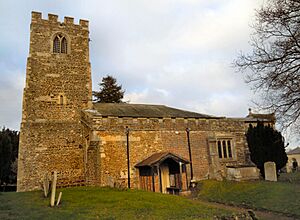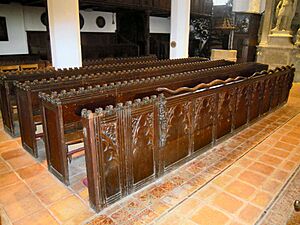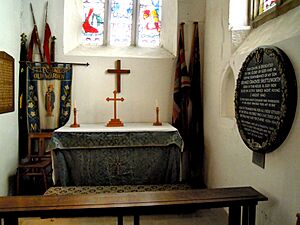Church of St Leonard, Old Warden facts for kids
The Abbey Church of St Leonard of Old Warden is a very old and important church located in Old Warden, Bedfordshire, England. It's so special that it's a Grade I listed building, which means it's considered one of the most important historic buildings in the country. It received this special status on October 31, 1966.
Contents
Exploring the Church's Design
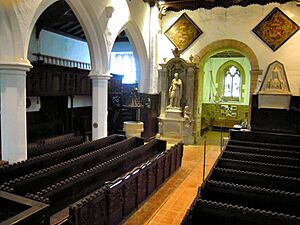
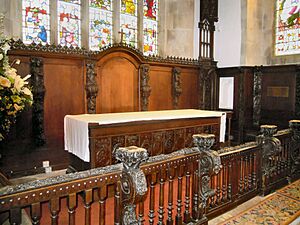
St Leonard's Church is named after a saint called Leonard of Noblac. The church building started in the early 1100s, but most of what you see today was built in the 1200s. Over the years, more parts were added in the 1300s, 1400s, and 1500s. The bottom part of the tower, including its archway, is from the 1100s (Norman style). The rest of the tower was rebuilt in the 1400s.
The church was greatly updated in the mid-to-late 1800s. That's when the amazing wooden decorations inside were added. The church is mostly built from brown cobblestones with special limestone details. Some newer parts use red brick and cut limestone. The south porch, which is the entrance on the south side, was built in 1952. It has a wooden frame with red bricks and a tiled roof. Mrs. Dorothy Shuttleworth had it built to remember her son, Richard Ormonde Shuttleworth (1909-1940).
Beautiful Wooden Carvings
Today, the church is famous for its incredibly detailed wooden carvings. A man named Robert Henley-Ongley, the 3rd Baron Ongley, had these carvings added in the mid-1800s to "beautify" the church. These carvings came from many different times and places, mostly from Belgium, France, and Italy.
Some people believe that certain panels came from the private chapel of Anne of Cleves. You can spot these because they have the initials "AC" with a crown above them. Sadly, in 1997, 15 wooden panels showing Bible stories were stolen from the church and were never found. The church plans to replace them with new carvings that look similar.
Stained Glass and Memorials
A special part of the church is the old stained glass from the 1300s, found in the north wall. This glass was originally in a nearby place called Wardon Abbey. It shows St Margaret holding a rope on the right side. On the left, you can see an Abbot (a leader of a monastery) from Wardon Abbey, wearing the white clothes of a Cistercian monk.
Further along the north wall, in the chancel (the area near the altar), there's a marble plaque. It was made by a sculptor named Goscombe John. This plaque was put there by Mrs. Dorothy Shuttleworth to remember her husband, Frank Shuttleworth (1845-1913). Later, some words were added to the plaque to also remember their only son, Pilot Officer Richard Ormonde Shuttleworth. He was killed in a flying accident during World War II while serving in the Royal Air Force. The lectern, which is a stand for reading, has the eagle symbol and motto of the Royal Air Force. Mrs. Shuttleworth also gave this in memory of her son.
Pulpit, Altar, and Pews
The carved wooden pulpit (where sermons are given) shows scenes of Jesus with children and the Woman of Samaria. It's likely from the 1700s and from Flanders (a region in Belgium). Frank Shuttleworth bought it from an antique shop. It used to have carvings of the symbols of the Four Evangelists (the writers of the Gospels) on its pillars, but these were stolen in 1997.
The wooden panels on the front of the altar (the table used for religious services) are from the late 1800s. The serpents (snakes) carved on the front pew are very interesting. One was damaged during the 1997 burglary and was fixed by local craftspeople. The second serpent was stolen and later replaced. The large box pew at the front of the nave (the main part of the church) was where the Shuttleworth Family sat. It has a beautiful carving of women preparing the body of Christ. Above this pew is a large, fancy baroque carving that represents Faith. It was put there by Caroline Jane Shuttleworth's sister to remember her after she passed away in 1899.
Monuments and Features
At the back of the nave is a life-size monument made by Peter Scheemakers and Laurent Delvaux. It honors Sir Samuel Ongley (1647–1726). He was a Member of Parliament, a director of the East India Company, and a leader in the South Sea Company. Only one small angel figure (called a putto) remains on the monument, as the other was stolen in the 1997 burglary.
The octagonal (eight-sided) wooden tiles set into two pillars were placed there when the church was restored during the time of Queen Mary, the daughter of Henry VIII. These tiles have her initial on them. The gallery, which is a raised walkway along the south wall of the nave, was added in 1841 by Lord Ongley. The panels with blank arches are English and are thought to be from the Elizabethan or Jacobean periods (late 1500s to early 1600s). The baptismal font (a basin for baptisms) is from the 1300s. It has a fancy canopy from the mid-1800s, designed in the Gothic Revival style.
The Richard Shuttleworth Chapel
In 2008, some changes happened at the Shuttleworth Chapel in Old Warden Park. Because of this, St Leonard's Church received many items from that chapel. These included two flags, two lances with special flags, linen and lace altar cloths, a wooden cross, and candlesticks.
Along with these items came an oval plaque with the Shuttleworth family crest and Royal Air Force wings. This plaque is dedicated to Richard Ormonde Shuttleworth (1909-1940), who was a racing driver and aviator. He was killed in a flying accident while serving in World War II and is buried in the churchyard. This plaque is now placed in the Chapel, which is in the south nave part of the church.
The window above the altar in the Richard Shuttleworth Chapel was given by his father, Frank Shuttleworth. It was meant to celebrate the Coronation of Edward VII. However, the date shown in the window is incorrect. The window was finished before the Coronation, which had to be delayed because the King was ill.
The Church Bells
The church has six bells. The oldest bell, number 5, is more than 400 years old! Bell number 3 was first made in 1653 by a bell-maker named Miles Graye, but it was recast (melted down and remade) in 1976. The largest bell, called the tenor bell, was recast in 1840 by Thomas Mears of London. Bells number 1 and 2 were made by Taylor of Loughborough. Colonel Frank Shuttleworth added them in 1897 to celebrate Queen Victoria's Diamond Jubilee, which marked 60 years of her being queen.
Notable People Buried Here
Many interesting people are buried in the churchyard of St Leonard's. Here are a few:
- Admiral Sir Lionel Halsey (1872–1949): A high-ranking officer in the Royal Navy and a close helper to the Royal Family.
- Sir Ralph Endersby Harwood (1883–1951): He was the Financial Secretary to Kings George V, Edward VIII, and George VI.
- Robert 'Bob' Lang (1840-1908): He was the Vicar (a type of priest) of St Leonard's from 1892 to 1902. He also played first-class cricket for Cambridge University from 1860 to 1862.
- Robert Henley-Ongley, 1st Baron Ongley (c.1721–1785): A British politician.
- Sir Samuel Ongley (1647–1726): An English politician.
- Richard Ormonde Shuttleworth (1909-1940): A famous racing driver and aviator.
In the north-east corner of the churchyard, you'll find the Ongley Family mausoleum. This is a special building built in 1790 for burials. It has 42 spaces for coffins, but only 10 of them were ever used.
Gallery
-
Sir Samuel Ongley's monument in St Leonard's church
-
The baptismal font
-
The baroque memorial to Caroline Shuttleworth (died 1899)
-
Robert Henley-Ongley's memorial in St Leonard's church
See also
- Grade I listed buildings in Bedfordshire


